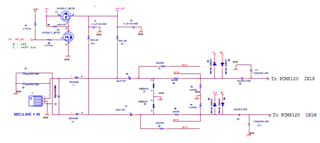Dear TI support team,
I intend to use PCM5120 as a MIC/ LINE In input as circuit draft below:

The J1 is a common jack for MIC and LINE Input.
When MIC is selected, SW1 is ON so that R1 is in parallel to R5, R2 is in parallel to R6. When LINE IN, these switches are open.
My question is: Is there a need of opamp as buffer before C8/C9 when they connect to PCM5120 input ?
Best regards,
SG


